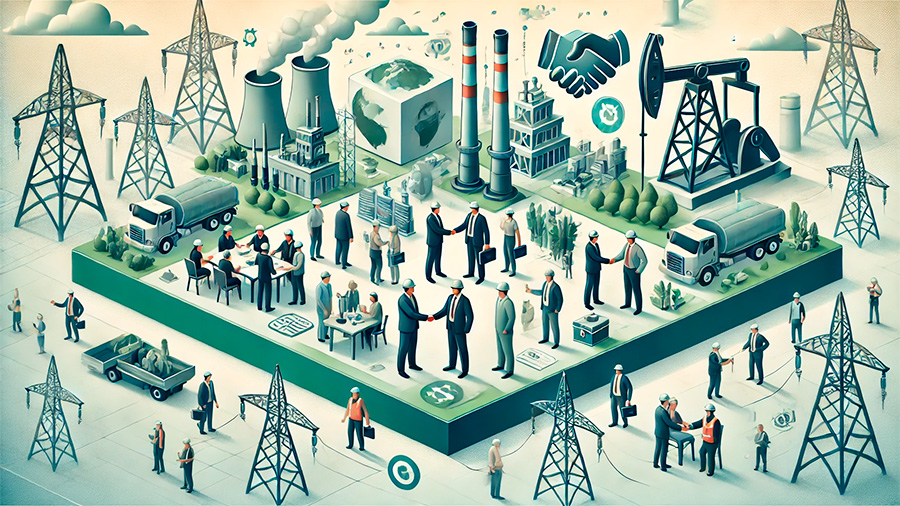
Building Resilience in the Energy Sector: Mitigating the Impact of Strikes
Strikes in the energy sector can have far-reaching consequences, disrupting national economies and threatening the stability of essential industries. The energy sector powers nearly every aspect of modern life, from transportation and manufacturing to heating and electricity. When energy workers go on strike, the supply of oil, gas, and electricity can be significantly reduced, leading to price spikes, supply chain disruptions, and even shortages in other critical sectors. This can have a ripple effect, hampering economic growth and undermining national security.
Preventing strikes in the energy sector is crucial for maintaining economic stability and ensuring the continuous flow of resources that industries and consumers rely on. Governments and energy companies must work together to address the root causes of strikes, implement preventive measures, and create contingency plans to mitigate the impact of labor disputes.
This article explores the impact of energy sector strikes on national economies and discusses strategies for preventing and managing these disruptions to ensure economic security.
The Economic Impact of Energy Sector Strikes
The energy sector is vital to the functioning of modern economies. It supplies the power needed to fuel industries, transport goods, and keep homes and businesses running. When strikes occur in this sector, they can cause immediate and severe economic disruptions. The longer a strike lasts, the more profound its impact on supply chains, production capabilities, and consumer prices. The energy sector’s role as a foundational industry makes it particularly vulnerable to labor disputes, which can have widespread consequences.
1. Supply Chain Disruptions
Strikes in the energy sector can lead to significant disruptions in supply chains that rely on the steady availability of fuel and electricity. Industries such as manufacturing, transportation, and agriculture are heavily dependent on energy resources to maintain operations. When energy production slows or halts due to a strike, businesses face shortages of critical resources, leading to delays, reduced productivity, and increased operational costs.
How strikes disrupt supply chains:
- Fuel shortages: A strike in oil or gas production can lead to shortages of fuel, impacting transportation, manufacturing, and other industries.
- Electricity interruptions: Power generation strikes can cause blackouts or reduced electricity supply, disrupting operations in energy-intensive industries.
2. Increased Energy Prices
One of the most immediate economic consequences of energy sector strikes is the rise in energy prices. Reduced energy supply caused by strikes often leads to price increases for consumers and businesses alike. As energy prices rise, the cost of goods and services across the economy also increases, contributing to inflationary pressures. This can erode consumer purchasing power, reduce business profitability, and slow overall economic growth.
Impact of strikes on energy prices:
- Higher consumer costs: Rising energy prices increase the cost of living for consumers, particularly in heating, electricity, and transportation.
- Inflationary pressures: Energy price spikes lead to higher production costs for businesses, resulting in price increases for goods and services across the economy.

Preventing Strikes in the Energy Sector
Given the critical role that energy plays in the economy, it is essential to prevent strikes before they occur. Proactively addressing the root causes of labor disputes and fostering positive relationships between energy companies and workers is key to avoiding disruptions. Governments, labor unions, and energy companies must collaborate to create solutions that prevent strikes while ensuring fair working conditions and wages for employees.
1. Addressing Labor Disputes Early
Many strikes in the energy sector arise from unresolved labor disputes, often related to wages, working conditions, or job security. One of the most effective ways to prevent strikes is to address these disputes before they escalate into labor actions. Early negotiations between labor unions and management can help resolve issues before tensions rise. Governments can also play a role by offering mediation services or facilitating discussions to help reach an agreement.
Strategies for resolving labor disputes early:
- Open communication: Encouraging transparent communication between employees and management can help identify and address issues before they escalate.
- Government mediation: Governments can provide mediation services to help resolve labor disputes quickly and prevent strikes.
2. Ensuring Fair Compensation and Working Conditions
One of the primary reasons for strikes in the energy sector is dissatisfaction with wages, benefits, or working conditions. To prevent strikes, energy companies must ensure that workers are fairly compensated and that their working conditions meet safety and health standards. Offering competitive salaries, providing adequate benefits, and ensuring a safe working environment can reduce the likelihood of labor unrest.
How fair compensation prevents strikes:
- Competitive wages: Offering wages that reflect the importance of energy workers’ roles helps prevent dissatisfaction and labor disputes.
- Improved working conditions: Ensuring safe and healthy work environments reduces the risk of labor grievances that can lead to strikes.
Mitigating the Impact of Strikes on National Economies
While preventing strikes is the ideal solution, it is also important to have strategies in place to mitigate the economic impact if strikes do occur. Governments and energy companies must prepare contingency plans to ensure that essential services continue to operate during labor disruptions. These plans can help minimize the impact of strikes on supply chains, energy prices, and economic stability.
1. Developing Contingency Plans
Contingency plans are essential for ensuring that critical energy supplies are maintained during strikes. These plans should include alternative sources of energy, such as backup power generators, fuel reserves, or alternative suppliers. Governments can also establish emergency measures to ensure the continuity of essential services, such as hospitals, transportation, and public utilities, during labor disruptions.
Key components of contingency plans:
- Alternative energy sources: Identifying alternative suppliers or backup energy sources can help maintain energy supply during strikes.
- Emergency fuel reserves: Governments can establish fuel reserves to ensure that essential services continue operating during labor disruptions.
2. Promoting Energy Diversification
Energy diversification is another key strategy for mitigating the impact of strikes in the energy sector. By investing in a mix of energy sources, such as renewable energy, nuclear power, and fossil fuels, governments can reduce their dependence on a single source of energy. This diversification makes the energy sector more resilient to labor disruptions, as it provides multiple avenues for meeting energy demand during strikes.
Benefits of energy diversification:
- Reduced reliance on fossil fuels: Diversifying energy sources reduces the impact of strikes in oil and gas production by ensuring alternative power supplies.
- Enhanced energy security: A diverse energy mix improves a country’s ability to maintain stable energy supplies during labor disruptions.

Long-Term Solutions for Energy Sector Stability
Ensuring long-term stability in the energy sector requires a multifaceted approach that addresses both labor relations and broader structural issues within the energy industry. Governments and energy companies must work together to create a stable and predictable energy market that benefits both workers and the economy. This includes investing in workforce development, promoting sustainability, and ensuring that energy companies are financially stable.
1. Investing in Workforce Development
One of the long-term strategies for preventing strikes and ensuring stability in the energy sector is investing in workforce development. Providing workers with training, education, and career advancement opportunities can improve job satisfaction and reduce the likelihood of labor disputes. Governments and energy companies can collaborate on initiatives that help workers develop new skills, particularly in emerging energy fields such as renewable energy and smart grid technology.
How workforce development promotes stability:
- Training and education: Offering opportunities for skill development helps workers advance in their careers and fosters job satisfaction.
- Adapting to industry changes: Workforce development programs help workers adapt to shifts in the energy industry, such as the transition to renewable energy.
2. Promoting Financial Stability in Energy Companies
Financial instability within energy companies can lead to labor disputes, particularly if companies are forced to reduce wages or benefits in response to economic challenges. Ensuring that energy companies are financially stable and well-positioned to weather economic fluctuations is key to maintaining stable labor relations. Governments can support financial stability through regulatory frameworks that promote responsible business practices, as well as by offering financial support or incentives for energy companies during times of crisis.
How financial stability prevents labor disputes:
- Ensuring wage stability: Financially stable companies are better able to offer competitive wages and benefits, reducing the risk of strikes.
- Promoting long-term investment: Financially healthy energy companies can invest in long-term projects that benefit both workers and the economy.
Conclusion
Strikes in the energy sector pose significant risks to national economies, disrupting supply chains, raising energy prices, and undermining economic stability. Preventing these strikes requires proactive strategies, including addressing labor disputes early, ensuring fair compensation, and developing contingency plans. By investing in workforce development, promoting energy diversification, and ensuring the financial stability of energy companies, governments and energy companies can reduce the likelihood of strikes and ensure long-term stability in the energy sector. These efforts are essential for protecting the economy and maintaining the continuous flow of energy resources that industries and consumers rely on.
